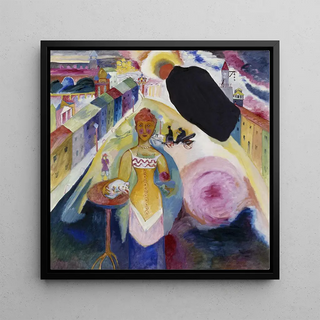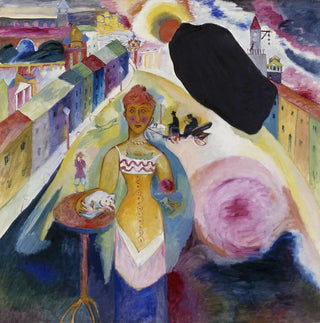Lady in Moscow - Wassily Kandinsky

The vibrant geometry of Lady in Moscow: Wassily Kandinsky's pictorial dynamism
In Lady in Moscow, Kandinsky orchestrates a visual composition where shapes and colors interact intensely. Angular planes, chromatic flat areas, and touches of black structure a composition that is both dynamic and lyrical, evoking urban movement and inner emotion. The palette combines warm tones with contrasting accents, while the expressive technique reveals the desire to translate the invisible into the visible. The work invites multiple interpretations, oscillating between emerging abstraction and subtle figurative reference, creating an atmosphere that is both enigmatic and captivating.
Wassily Kandinsky, master of emerging abstraction
Wassily Kandinsky, pioneer of abstraction in the early 20th century, profoundly influenced the evolution of modern art through his color theory and pursuit of pictorial spirituality. Trained between Moscow and Munich, he combines Russian heritage with European avant-gardes, contributing to the Blue Rider movement and debates on synesthesia in painting. His canvases blend musical composition and chromatic symbolism, making each work a formal and intellectual exploration. Kandinsky left a rich body of graphic and conceptual experiments, of which Lady in Moscow exemplifies the ability to translate emotions and ideas into innovative visual language.
A decorative acquisition with multiple advantages
This art print of Lady in Moscow fits equally well in a contemporary living room, a creative office, or an artistically inspired bedroom, adding character and depth to the space. Created with a focus on chromatic fidelity and print quality, the canvas captures the subtlety of nuances and the strength of the original contrasts. Choosing this Lady in Moscow art print means selecting a piece that interacts with light and transforms a room into a focal point. The Lady in Moscow art print offers a refined option for those wishing to enrich their decor with a work inspired by the history and inventiveness of Kandinsky.

The vibrant geometry of Lady in Moscow: Wassily Kandinsky's pictorial dynamism
In Lady in Moscow, Kandinsky orchestrates a visual composition where shapes and colors interact intensely. Angular planes, chromatic flat areas, and touches of black structure a composition that is both dynamic and lyrical, evoking urban movement and inner emotion. The palette combines warm tones with contrasting accents, while the expressive technique reveals the desire to translate the invisible into the visible. The work invites multiple interpretations, oscillating between emerging abstraction and subtle figurative reference, creating an atmosphere that is both enigmatic and captivating.
Wassily Kandinsky, master of emerging abstraction
Wassily Kandinsky, pioneer of abstraction in the early 20th century, profoundly influenced the evolution of modern art through his color theory and pursuit of pictorial spirituality. Trained between Moscow and Munich, he combines Russian heritage with European avant-gardes, contributing to the Blue Rider movement and debates on synesthesia in painting. His canvases blend musical composition and chromatic symbolism, making each work a formal and intellectual exploration. Kandinsky left a rich body of graphic and conceptual experiments, of which Lady in Moscow exemplifies the ability to translate emotions and ideas into innovative visual language.
A decorative acquisition with multiple advantages
This art print of Lady in Moscow fits equally well in a contemporary living room, a creative office, or an artistically inspired bedroom, adding character and depth to the space. Created with a focus on chromatic fidelity and print quality, the canvas captures the subtlety of nuances and the strength of the original contrasts. Choosing this Lady in Moscow art print means selecting a piece that interacts with light and transforms a room into a focal point. The Lady in Moscow art print offers a refined option for those wishing to enrich their decor with a work inspired by the history and inventiveness of Kandinsky.





